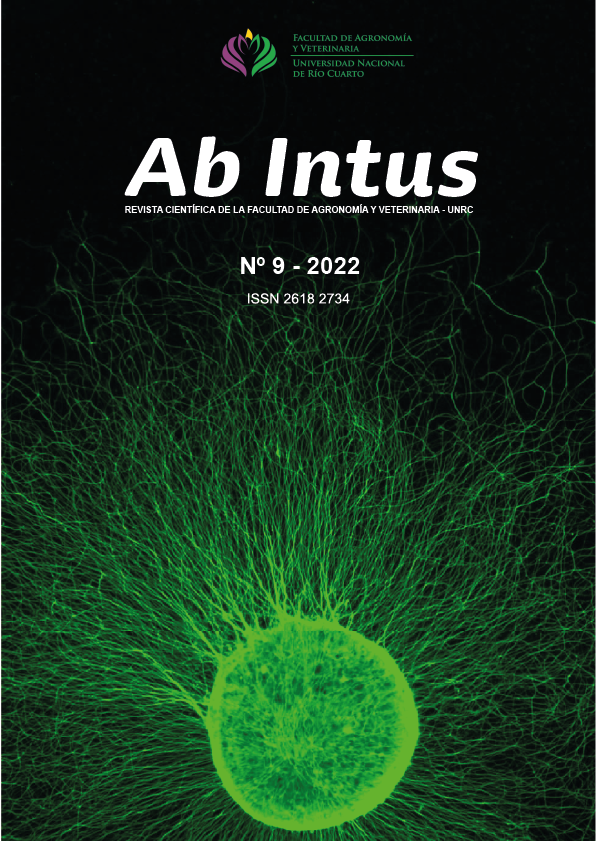Ver ítem
- xmlui.general.dspace_homeCentros Regionales y EEAsCentro Regional CórdobaEEA Marcos JuárezArtículos científicosxmlui.ArtifactBrowser.ItemViewer.trail
- Inicio
- Centros Regionales y EEAs
- Centro Regional Córdoba
- EEA Marcos Juárez
- Artículos científicos
- Ver ítem
Evaluación de híbridos de maíz frente a enfermedades fúngicas, en el centro-sur de la provincia de Córdoba = Evaluation of commercial corn hybrids against fungal diseases, in the central-south of the province of Córdoba
Resumen
El mercado de híbridos de maíz para producción de granos ofrece todos los años nuevos materiales, cuyo comportamiento a campo frente a las enfermedades y la adaptación a los diferentes ambientes varía según la zona de producción. El objetivo del trabajo fue cuantificar la intensidad de roya común y tizón del maíz en diferentes híbridos comerciales en la zona centro-sur de la provincia de Córdoba. Durante el ciclo 2020/2021, se realizó un ensayo de
[ver mas...]
El mercado de híbridos de maíz para producción de granos ofrece todos los años nuevos materiales, cuyo comportamiento a campo frente a las enfermedades y la adaptación a los diferentes ambientes varía según la zona de producción. El objetivo del trabajo fue cuantificar la intensidad de roya común y tizón del maíz en diferentes híbridos comerciales en la zona centro-sur de la provincia de Córdoba. Durante el ciclo 2020/2021, se realizó un ensayo de híbridos de maíz en Río Cuarto (Córdoba) con un diseño en BCA, con dos repeticiones y 10 surcos por híbrido cuantificando roya y tizón mediante incidencia, severidad y ABCPE en cuatro momentos del ciclo del cultivo. La incidencia de roya fue del 20% al 93% y aunque se discriminaron seis grupos según la severidad, ningún híbrido alcanzó el nivel de daño económico. Respecto al ABCPE para roya común solo un genotipo (LT 723 VT3Pro) se diferenció del resto, el que presento el máximo valor de severidad. Para el tizón del maíz, la incidencia fue del 20% al 68% y un solo híbrido alcanzó 5,5% de severidad diferenciándose dos grupos según este parámetro, mientras que para el ABCPE solo dos materiales (P1815 VYHR y Tob 767) se diferenciaron significativamente del resto. Se concluye que en siembras tardías y con buenas condiciones ambientales para el cultivo, todos los híbridos evaluados presentaron muy buen comportamiento a roya del maíz y buena tolerancia a tizón, existiendo diferente comportamiento de los híbridos de maíz disponibles en el mercado respecto a ambas enfermedades.
[Cerrar]
Every year the market for corn hybrids for grain production offers new materials whose behavior in the field against diseases and adaptation to different environments are not known. The objective of the work was to quantify the intensity of common rust and corn blight in different commercial hybrids in the central-southern zone of the province of Córdoba. During the 2020/2021 cycle, a corn hybrid trial was carried out in Río Cuarto (Córdoba) with a BCA
[ver mas...]
Every year the market for corn hybrids for grain production offers new materials whose behavior in the field against diseases and adaptation to different environments are not known. The objective of the work was to quantify the intensity of common rust and corn blight in different commercial hybrids in the central-southern zone of the province of Córdoba. During the 2020/2021 cycle, a corn hybrid trial was carried out in Río Cuarto (Córdoba) with a BCA design, with two repetitions and 10 rows per hybrid, quantifying rust and blight by incidence, severity and ABCPE at four moments of the cycle. of the crop. The incidence of rust was 20%-93% and no hybrid reached the level of economic damage, although six groups were discriminated according to severity. Regarding the ABCPE for common rust, only one genotype (LT 723 VT3Pro) differed from the rest,
who presented the maximum severity value. For corn blight, the incidence was 20%-68% and a single hybrid reached 5.5% severity, differentiating two groups of hybrids according to this parameter, while for ABCPE only two materials (P1815 VYHR and Tob 767) differed significantly from the rest. It is concluded that in late sowings and with good environmental conditions, all the evaluated hybrids presented a very good behavior to corn rust and a good tolerance to blight, with different behavior of the corn hybrids available in the market regarding both diseases.
[Cerrar]

Autor
Zuza, Mónica Silvina;
Kearney, Marcelo Isaías;
Costa, Matías;
Peralta, Vanesa Soledad;
Salomon, Anibal Alejandro;
Canale, Alejandra;
Fuente
Ab Intus 9 (5) : 25-34 (julio 2022)
Fecha
2022-07
Editorial
Facultad de Agronomía y Veterinaria, Universidad Nacional de Río Cuarto
ISSN
2618-2734
Formato
pdf
Tipo de documento
artículo
Palabras Claves
Derechos de acceso
Abierto
 Excepto donde se diga explicitamente, este item se publica bajo la siguiente descripción: Creative Commons Attribution-NonCommercial-ShareAlike 2.5 Unported (CC BY-NC-SA 2.5)
Excepto donde se diga explicitamente, este item se publica bajo la siguiente descripción: Creative Commons Attribution-NonCommercial-ShareAlike 2.5 Unported (CC BY-NC-SA 2.5)


